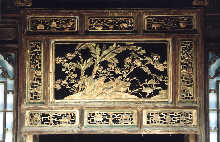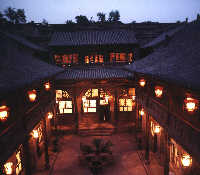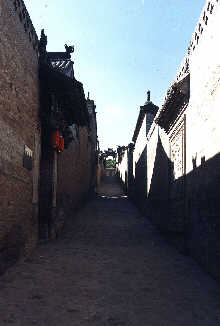 With a history of more than 680 years, the Wangs have lived on for 27 generations throughout all the ups and downs. Now there are some newly emerged talents in various fields from the Wangs. Upon gazing at the Wang Grand Courtyard, one can vividly feel the history of China in the past few centuries through the legend of one common family.
With a history of more than 680 years, the Wangs have lived on for 27 generations throughout all the ups and downs. Now there are some newly emerged talents in various fields from the Wangs. Upon gazing at the Wang Grand Courtyard, one can vividly feel the history of China in the past few centuries through the legend of one common family.
The construction style and folk customs
With a time-honored history, Jingsheng is a famous historical and cultural town. Archeological finds have revealed apainted potterysite of the Neolithic Age in the town, demonstrating that Chinese ancestors have dwelt in the place a long time. The tomb cluster dating form theShang Dynasty (About 16th - 11th century BC) boasts a lot of precious relics from theBronzeAge. The cultural relics from the Qin and Han dynasties (221BC-220AD) also abound in the town. Currently, there are still many buildings in Jinsheng that were built in theYuan Dynasty(1271-1368).
(About 16th - 11th century BC) boasts a lot of precious relics from theBronzeAge. The cultural relics from the Qin and Han dynasties (221BC-220AD) also abound in the town. Currently, there are still many buildings in Jinsheng that were built in theYuan Dynasty(1271-1368).
The Grand Courtyard of the Wangs, deliberately protected and left from theQing Dynasty, boasts strong ethnic Chinese flavor and occupies an important position in Chinese construction history.
 The mansions of the family are rather luxurious, as the family paid little attention to the production cost. In theKangxiReign of the Qing Dynasty, the Wangs built the first two lanes named Yongcui and Suorui for their mansions in Jingsheng. In theQianlongReign, the Zhongling lane was built, and the Hongmen, Gongji, and Dongnan fortresses were also built to form a dwelling area for the Wangs. During theYongzhengReign, the Chongning Fortress was built. Two Wang members, Wang Rucong and Wang Rucheng, built the Gaojiaya dwelling area, the last construction cluster.
The mansions of the family are rather luxurious, as the family paid little attention to the production cost. In theKangxiReign of the Qing Dynasty, the Wangs built the first two lanes named Yongcui and Suorui for their mansions in Jingsheng. In theQianlongReign, the Zhongling lane was built, and the Hongmen, Gongji, and Dongnan fortresses were also built to form a dwelling area for the Wangs. During theYongzhengReign, the Chongning Fortress was built. Two Wang members, Wang Rucong and Wang Rucheng, built the Gaojiaya dwelling area, the last construction cluster.
Gaojiaya began to be built in 1796 and finished in 1811. After 16 years, the whole construction covered 11,728 square meters with 26 courtyards and 218 rooms. The features of the mansion are as follows:
First, the whole construction faces the river, away from the mountain. The buildings were established upon the fully advantages of the landscape of the hills, which makes the whole compound appear scattered in a graceful manner. Layers of gardens on different heights of the hill give the compound more levels and the hill more vibrancy and glamour.